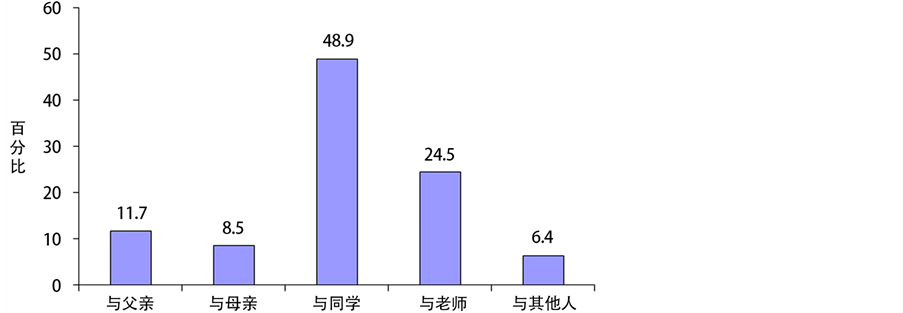1. 引言
随着社会的发展,人们对幸福的理解以及健康的追求都发生着改变,不仅仅关注身体的舒适,更注重心理的需求。心理健康关系着每个人、每一个家庭的幸福甚至社会的安宁,如何提高心理素质水平,增进心理健康,应对各种危机已成为人生的必修课。为引起人们对精神疾病的重视,世界卫生组织把新世纪的第一年定为“精神卫生年”,因此正确认识及预防心理疾病的重要性不言而喻。
据世界卫生组织(WHO)推算,2020年全球精神疾病占所有疾病负担的比例会由1990年的11%升至15% [1] ,其中精神残疾将占残疾人中的1/3,且中低等收入国家的精神障碍负担占全球的3/4 [2] [3] 。以国际上衡量健康的伤残调整年指标为依据来评价各类疾病的总体负担,可知精神疾病排名居首位,超过心脑疾病、呼吸系统及肿瘤等疾病,占疾病总负担的20% [4] 。根据卫生部公布的数据,我国现有1600万重型精神病患者,各类精神病患病率为13.47%。因此寻求有效的预防和控制精神疾患的手段已逐渐成为全社会关注的焦点和热点。进入新世纪以来,国家大力发展开展精神卫生工作,《中国精神卫生工作规划(2002~2010)》 [5] 及国务院办公厅转发的《全国精神卫生工作体系发展指导纲要(2008~2015)》 [6] 确立的工作目标强调,今后的主要任务之一是提高人们的精神卫生知识的知晓率,使普通人群心理知识和预防精神疾病知识的知晓度2005年达30%,2010年50%,2015年80%。但是,据王晓玲等人的长沙市中学生心理卫生知识知晓率调查 [7] 、杨小龙等人的兰州市大中学生精神卫生知识知晓率调查 [8] 、西英俊等人的北京某高校大学生精神卫生知晓率的调查 [9] 结果可知,大学生的精神卫生知识的知晓率普遍偏低。
精神卫生问题不仅仅是医疗卫生问题,更是突出的社会问题、公共卫生、法律问题,对精神健康的关注是对人的根本关注 [10] 。在经济快速发展,工业化、城市化、市场化、人口老龄化呈加速趋势的中国,社会竞争不断加剧,各种心理应激因素急剧增加,心理行为问题日益凸显。自1995年和1997年清华、北京两所大学的铊盐投毒事件,到2004年的马加爵案、扬州大学的秋水仙碱投毒事件,再到中国矿业大学2007年的铊盐投毒事件,到现今的复旦大学投毒事件。这一起起校园事件令人发指,发人深思,人们急切呼唤校园心理的“牧羊人”。
目前,提高人群心理卫生知识知晓率是当前我国精神卫生工作的重要任务。要提高,首先就必须通过恰当的抽样调查了解现状。自《全国精神卫生工作体系发展指导纲(2008~2015年)》发布以来,2013年是特殊的一年,该年5月,我国第一部《精神卫生法》正式实施,该法有效填补了精神卫生领域的法律空白 [11] 。在这样具有里程碑意义的新的一年的影响下,人们对于心理卫生方面知识的了解究竟怎么样,暂时还很少见此方面的调查,尽管以前也有这方面的调查 [12] - [14] ,但是时间和背景有所差异,所以此次调查目的是为了解入学新生的心理卫生方面的知识的基本状况,为以后开展心理健康教育和宣传、提高学生的心理卫生知识水平、增强学生的心理素质提供一些理论依据。
2. 对象与方法
2.1. 调查对象
此次调查对象为豫北地区两所高校的大一入学新生,采用分层整群随机抽样法, 从每个高校中抽取100人,然后于采用简单随机抽样方法在每个高校中随机选取 4个班,最后在每个班内随机选取25人,共抽取8个班的不同专业的新生,共发放问卷200份,有效问卷188份,有效回收率为94%。年龄最小的被试为16岁,最大的为22岁,其中男生有77人(41%),女生有111人(59%),总体的平均年龄为18.9岁,男生平均年龄为18.96岁,女生平均年龄为18.86岁。
2.2. 调查方法
此次调查使用上海朱青紫等人编制的《大中学生心理卫生知识知晓率调查问卷》 [15] ,内容涉及到对心理卫生知识、以及对心理健康问题的态度和行为等方面,此问卷经多次验证具有较高的信度和效度。根据需求另加一开放问题,询问对于2013年最新出台的《精神卫生法》的了解。该问卷共有21题,6题为公共是否型题目,15题为正误选择型题目。正确率 = 回答正确的项目/总的统计项目 × l00%。得分大于60%为知晓合格。知晓率 = 知晓合格人数/抽样人数 × 100%。此调查采用匿名调查法,将所有的调查对象集中在一个比较安静的大教室,由调查员讲解调查目的、意义、填表方法及注意事项后,由调查对象当场独立完成并统一回收。
2.3. 统计方法
此次调查的统计分析采用SPSS17.0统计软件对问卷条目的正确回答进行频数和百分比的描述性统计分析。
3. 结果
3.1. 心理卫生知识回答的正确率和知晓率
3.1.1. 心理卫生知识回答的正确率
188名大一新生各项心理卫生知识回答正确率如表1所示。此次调查结果显示统计项正确率分布在10.1%~96.3%之间,评分题目回答平均正确率为56.95%。标准差为0.283,男生正确率为55.85%,女生的正确率为57.72%,差异无统计学意义。
3.1.2. 心理卫生知识回答的知晓率
188名入学新生的心理卫生知识知晓率情况如表2。此次调查显示入学新生的心理卫生知识知晓率为63.8%。男生知晓率为61.5%,女生为66.1%,差异并没有统计学意义。
3.2. 心理卫生知识具体应答情况
3.2.1. 对心理健康知识的正确性认识
关于心理健康的概念,89.9%的学生正确地认识。92.6%的人认为“精神病”和“神经病”是不一样的疾病。93.1%的学生认为精神疾病在医生的指导和自己的积极配合下能够治疗好,像正常人一样自在地

Table 1. The correct rate of mental health knowledge
表1. 心理卫生知识的正确率

Table 2. Awareness rate of mental health knowledge
表2. 心理卫生知识的知晓率
生活。66%的学生认为患精神疾病的人在病情稳定期间能正常的参与到工作中。对于精神卫生日的正确时间仅有36.2%的学生知道,如图1。仅有3.2%的学生知道《精神卫生法》的实施。
3.2.2. 对学习问题的认识
对于学生学习成绩差的原因,结果显示仅有29.8%的学生能够全面正确地认识到学习成绩差的真正
原因。对于在学习过程中产生的疲劳现象83%的人知道如何应对。
3.2.3. 对心理异常状态的认识
据调查显示,87.8%的学生能正确分辨考试焦虑症,但只有27.1%的学生能正确识别社交焦虑症和抑郁症。
3.2.4. 心理卫生知识的来源
对于心理卫生方面的话题有相当一部分学生比较关注,占总人数的76.1%。如图2,64.4%的学生获得心理卫生方面知识的,来源是学校的教育。其余依次为聊天13.3%、网络12.2%、长辈10.1%。92%的学生知道学校有心理咨询室,但是当自己有心理方面的问题时,44.1%的学生首先主要选择找朋友倾诉,想要通过心理卫生机构来帮助自己的人仅10.1%,借助阅读书籍自己帮助自己的有21.3%,通过自我反省的学生有24.5%。
3.2.5. 对青春期人际关系的认识
调查显示,93.6%的学生几乎都受到人际关系的困扰,其中同学之间关系困扰的比例是最大的,为48.9%。其余依次为老师24.5%、父亲11.7%、母亲8.5%,如图3所示。对于青春期的心理冲突,58%的人能够全面地认识到学生常见的心理冲突。87.2%的学生认为子女的“逆反”行为是由于青春期自身意识增加,需要父母的理解和包容。96.3%的认为青春期的男女喜欢在一起是心理发展的一种正常现象。

Figure 1. The number of people knowing mental health day
图1. 精神卫生日知晓人数

Figure 2. Sources of mental health knowledge
图2. 心理卫生知识的来源

Figure 3. Types of interpersonal relationship problems
图3. 人际关系困扰种类
4. 讨论
4.1. 精神卫生知识普及率低
2008年1月,卫生部、中宣部、财政部等17个部委、社会团共同印发了《全国精神卫生工作体系发展指导纲要(2008年~2015年)》,该文件的工作目标二之指标2中要求,在学校开展心理健康教育的比例,2010年城市达80%、农村达50%;2015年城市达85%、农村达70%。提升人们的心理健康知识和精神疾病预防知识知晓率,2010年为50%,2015年目标为80%。调查发现入学新生的精神卫生知识的平均正确率为56.95%,精神卫生知识知晓率为63.8%,与2015年的目标还有一定的差距。此次调查结果与西英俊、周宾等人 [9] 所做的精神卫生知晓率调查和王变云等人 [16] 所做的宁波市大学生精神卫生知识知晓率调查结果基本一致,然而却与梁丽君 [17] 所做的精神卫生知识知晓率及对精神疾病态度的调查结果差异显著,这可能是由选取被试自身存在的差异性导致的,因此针对此现象,需要进一步的相关调查,从而了解新时代下我国精神卫生知识的宣传效果,为进一步做好相关预防工作提供参考依据。
4.2. 对《精神卫生法》的关注度不够
自新中国成立以来,精神卫生工作一直深受党和政府的高度重视,相关的法律和政策一直在一步步的不断建立和完善。近年来,我国精神卫生工作有了很大的发展,精神卫生工作体系初步形成,领导协调机制正在各地逐步建立,管理规范和制度陆续出台。2013年是特殊的一年,我国第一部《精神卫生法》于2013年5月1日正式实施,填补了我国精神卫生领域的法律空白,在这样具有里程碑意义的新的一年的影响下,人们理应非常关注《精神卫生法》,然而调查显示仅有3.2%的学生知道该法。因此,目前提高人群心理卫生知识知晓率是仍是我国精神卫生工作的重要任务。
4.3. 对心理异常状态认识不足
健康不仅指没有疾病,更是一种生理、心理和社会适应的良好状态。精神健康是健康不可缺少的一部分,没有躯体疾病不代表心理健康。每个人不仅需要身体健康,也需要心理健康 [18] 。研究结果显示,入学新生对心理健康概念、精神病/神经病、精神病患者在精神疾病稳定期间可以工作这几项的回答正确率比较高。可能是因为近年来的宣传力度加大,而且今年是特殊的一年,人们在一定程度上受到宣传的影响。然而,在某些心理知识方面入学新生的了解情况并不理想,尤其是对于心理异常状态的认识程度.仅有27.1%的学生能够正确辨别出抑郁症,值得注意的是,抑郁症已经成为当今世界最危害人类健康的疾病之一,全球疾病负担合作研究(1996)发现,预计到2020年,抑郁症将跃升至危害人类健康疾病的第二位,占全球疾病负担的15%。美国(1994) 4%的医疗费用于治疗抑郁障碍,高达430亿美元。亚太精神科学高峰会(2005)的报告显示,抑郁症在中国造成的总经济负担达622亿人民币 [19] 。调查结果仅有27.1%的学生能识别出社交焦虑症。总的来说,学生对于心理异常状态认识比较差。
4.4. 心理卫生保健资源利用率差
调查发现,64.4%的学生的心理卫生知识从学校教育获得,其后依次为聊天、网络、长辈那里获得。说明学校教育仍是获取心理卫生知识的主要途径。因此建议教育部门仍然应该将心理健康教育作为学校素质教育的重要内容,继续加大力度对于入学新生的精神卫生知识的宣传和教育,防微杜渐,为学生心理的健康发展提供良好的成长环境。尽管78.2%的学生知道学校拥有心理咨询资源,但只有10.1%的学生表示在遇到困扰时会求助于找心理卫生机构。而44.1%的学生会先找自己的朋友倾诉,借以解决自己的心理问题。说明大一新生的独立意识比较强,但是却不善于自己身边的保健资源。因此,卫生和教育部门应该相联合起来,从学生入学开始,通过宣传教育,使学生一步一步地认识到心理咨询在帮助自己解决心理问题方面的重要作用,进而使学生学会如何有效利用身边的资源,从而提高学生有效解决自身或者是帮助他人解决心理问题的能力。
4.5. 学生的人际关系问题亟待解决
人际交往是成长和发展的需要,对于大学生而言人际交往不仅仅是必不可少的,而且还是大学生努力学习的必修课,良好的人际关系对于大学生的发展有着至关重要的作用 [20] 。研究显示人际关系状况与大学生心理健康水平有显著相关,人际关系的质量是心理健康水平和适应能力的综合体现 [21] 。学生的交往能力偏弱使得人际问题成为一个重要课题。多年来,学生长期在高考的影响下,看重学习成绩而忽视实践能力等其他素质的培养 [22] 。进入大学后,学校对这方面的关注不够。因此出现许多学生的智商很高,情商却很低,处理不好与他人相处的问题。本次调查显示,93.6%的学生受到人际关系的困扰,其中受同学之间关系困扰的同学比例最大,为48.9%,与老师关系的困扰为24.5%。人际关系的困扰是不可避免的,如何尽最大的努力帮助入学新生从入校开始就能学会正确处理同学关系、教师关系以尽快很好地适应环境的转变,是心理卫生工作者与教育工作者的共同任务。同时,调查提醒学校教育不仅仅要关注学生的学习成绩,同时也应关注学生的心理健康。
5. 结论
总而言之,尽管入学新生的精神卫生知识知晓率虽然在一定程度上有所提高,但是距离2015年的目标还有差距,因此需要进一步深化入学新生心理卫生知识的宣传和教育。
基金项目
本文获得教育部人文社会科学研究青年基金项目:地震亲历者创伤心理的特点及其干预(11YJC190036)资助。